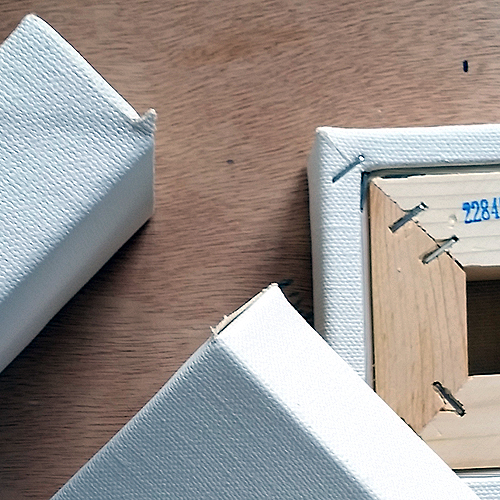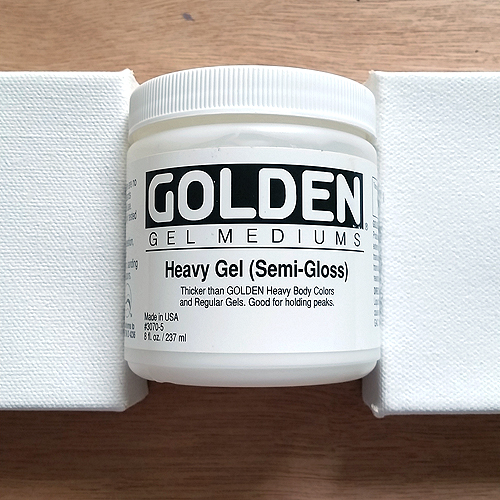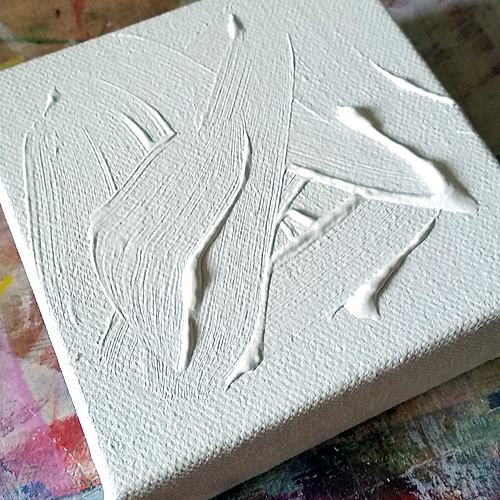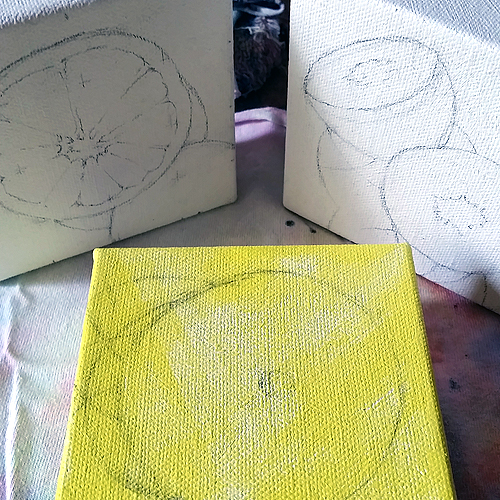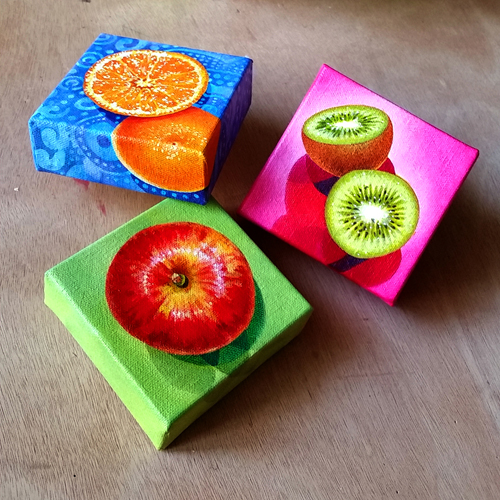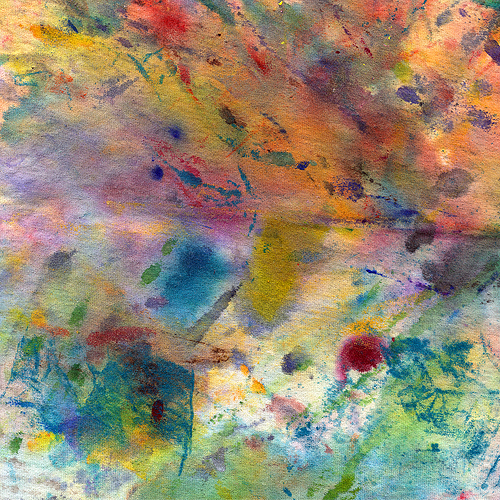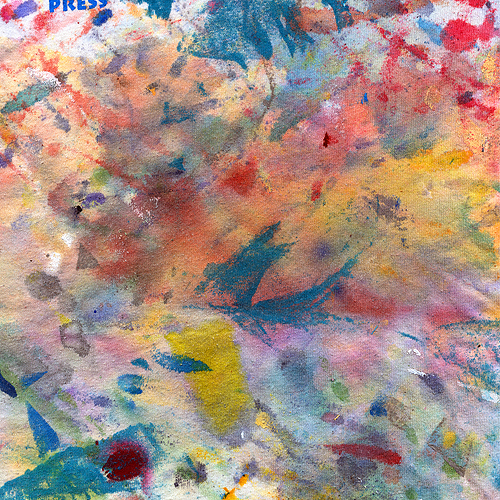Detritus, aka Making the Art Sausage
Note: This entry first appeared on my Patreon page, which is no longer active.
When we see a work of art hanging on a wall or seated on a pedestal, it looks like it appeared there by magic. You might get a hint of the work that went into its creation - brush strokes, fingerprints, chisel marks, and so on. But what don't you see?
The process of making a painting bleeds over into my surrounding workspace. There are a lot of leftover bits. Why let them go to waste?
Paint on the Palette
I'm using a glass palette these days for my acrylic paints. It's easier to clean than plastic, but there's an awkward side effect. When my acrylic paint begins to dry on the palette, it forms flakes that absolutely do not mix with wet paint. Grr.
My solution is to take a paper towel, fold it in quarters longways, saturate it with water, and squeeze out my paint onto that. I still use the glass for mixing color, and clean the mixtures off when I'm done.
If I unfold the paper towel carefully, the next day I have this cool object that's just begging to be collaged somewhere.
All the Trimmings
I've been using my extra paint to make postcards. They are standard-size and ready to be stamped and mailed. Or you can just set them on a shelf and enjoy.
I make these by cutting 9 x 12 Bristol board into quarters. However, there's a half-inch that needs to be trimmed in order to meet the USPS' standard postcard dimensions. I've been making a lot of postcards, and these strips are really accumulating. What will they become?
Trading Cards
Are you familiar with Artist Trading Cards? They're made where are collecting and business cards intersect. They're tiny - 2.5 x 3.5 inches - and that's where the standardization ends. I use ATC's as a great place to use up extra paint, switch gears, relax with a small piece, and then have something cool to give away or swap.* Will my Patreon patrons be getting Artist Trading Cards at some point? [Yes they did.]
* You can buy ATCs on eBay. But I prefer them to be gifted or traded hand-to-hand.
Deep-cleaning the Studio, Part 2
I've been away from the easel for the past several months on a self-directed quilting sabbatical. Now that it's 2016, I'm back into painting mode. I have a big exhibition coming up this fall, so I needed to get my painting space back in order. Read part 1 here.

First up, cleaning the shelf units that hold up my worktables.

A dust-free place for everything.

Index cards, indexed by type AND size. It's who I am.

In transition, taking the workspace apart...

Ready for the nasty dust pics? Here they come.

ULHH.

FLUULLGH.

GUUUUUHH.

But things got all better.

Aaahh.

Ready to work at my workspace.

Let's do some painting!
You may also enjoy: Prescription for an Installation Tools I Use: My Favorite Pens
Prescription for an Installation
These are the tools I pack when I’m preparing to hang a show of paintings. Click image to embiggen.
1. Packing tape for keeping boxes closed
2. Painter's tape - the blue stuff - easily removable
3. Extra picture-hanging wire just in case (Many of these items are just in case.)
4. Scissors
5. Wire cutters
6. Needle-nose pliers
7. Hammer
8, 9. Screwdriver & bits
10. Ruler
11. Scraper
12. A pen that writes on (just about) any surface
13. Pencil
14. Eraser
15. Extra D-ring hangers
16. Level
17. Screw eyes, small
18. Screw eyes, medium & large
19. Finishing nails, tiny
20. Finishing nails, small & medium
21. L-pins
22. Common nails
23. Scotch tape
24. Picture hanging hardware, various
25. Blade
26, 27. Dots. They go on the backs of pieces to protect the wall and keep the art from sliding around.
28. Microfiber dust cloth
Not Pictured:
- Art, packed up nice & snug
- Business cards, postcards, other promotional materials
- White gloves
- Measuring tape
- Visual inventory: includes thumbnails, titles, sizes, prices, my contact information, and a place for the artist and gallery to sign at install and pickup. I make 2 copies - one for them, one for me.
- Labels for the wall. Sometimes the venue provides these, sometimes not. This time I made them myself.
Let's do this thing.
Preparing a Canvas for Acrylic Painting
 I work almost exclusively in acrylic on canvas. For larger works I use unstretched canvas hanging it over a dowel rod, much the same way you would display a quilt or tapestry.
I work almost exclusively in acrylic on canvas. For larger works I use unstretched canvas hanging it over a dowel rod, much the same way you would display a quilt or tapestry.
But for my smaller works I use Blick Gallery Profile pre-stretched canvases.
Side note: Everyone who's been through art school has learned to build their own stretched canvases. I used to. Now it's more economical for me in terms of time and labor to order pre-made canvases in batches of 4-8. Want to learn to build canvases yourself? YouTube's got you covered.
Why Bother?
When someone buys my painting and takes it home, I want them to know that they have purchased a quality product that will last for decades to come - not something shabby that will fall apart in a year. The value of my work is more than the paint I've put on the canvas; it's in the care I've taken to ensure that my collectors enjoy living with my art. Prepping a canvas before painting is just one way to demonstrate that I care about my client's experience.
The preparatory process also prevents small problems that, added up, can really interfere with the final product.
Step 1: Corners
I buy these Blick canvases because they are very well-constructed. However, the corners do tend to come loose, and sometimes the canvas has been trimmed unevenly. (Not true of hand-built canvases; see note above re: economy.)
See those flappy edges? Even if I paint over them those are still weak spots that will get worse as the painting ages. I want to nip that in the bud.
I glue down those corners with Golden Heavy Gel.
I apply the gel undiluted to the corners of the canvas, both on the sides and the back, and press those flaps down hard. Any gel that squishes out gets smeared over the raw edges to seal them. It doesn't matter how much gel ends up being visible because I'm going to paint over the entire thing. I let them dry about 30 minutes.
Step 2: Sizing the Back
The canvases you see pictured here are very small - 4x4" each. This next step is much more important for larger canvases.
In most cases, a pre-stretched canvas will be primed on the front side only. Priming the other side strengthens the canvas and helps ensure its longevity. Also, the tighter your stretched canvas, the less likely you are to bump against the underlying stretchers while painting.
With a stiff brush, I wet down the back of the canvas. I make sure to get that water as far under the stretchers as possible. On a larger canvas, I follow up with diluted gesso. I brush both vertically and horizontally to work the water and gesso into the weave of the canvas. You'll notice right away that the canvas gets tighter. It will loosen a little after drying, but will be stronger for the additional gesso.
Step 3: Gesso Coat
I buy canvases pre-primed, but I like to add an additional thin coat of gesso to front and back before painting. The manufacturer's acrylic primer can sometimes resist initial paint application, causing the paint to bead up on the surface. Gesso is chalkier and will soak that first coat of paint right up.
Or maybe a super-fun and interesting thicker coat.
A little sanding may be in order on your stretchers. Nobody likes splinters, right?
Step 4: Rock Out
Now she's ready to go.
The Finished Product
Orange, Kiwi and Apple. Acrylic on canvas, 4x4" each, 2014 by Sarah Atlee Private commission
What are your tips for prepping before painting?
Let us know in the comments below.
Paint Rags
When painting, I always have a stack of cut-up t-shirts next to my water jug. These are the best material I've used to clean my brushes and wipe paint off (or around on) the canvas. Absorbent, durable, reusable - and there's always a worn-out t-shirt around if I need more.
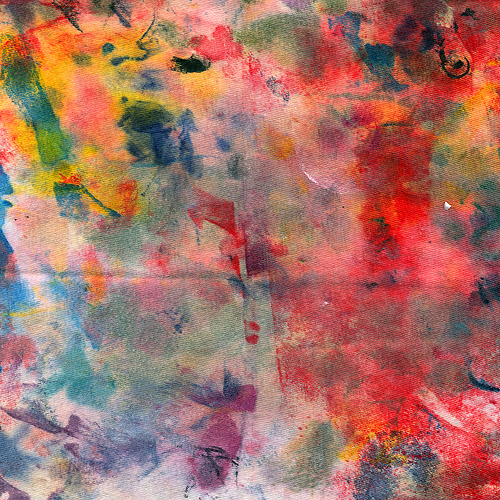
When they get full, I run them through the laundry to soften them back up. But after a certain point, they just won't absorb any more.
Would you throw these out? I certainly can't. They go into the collage material bin.





